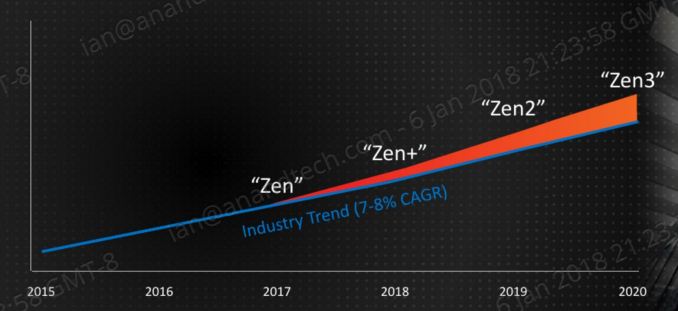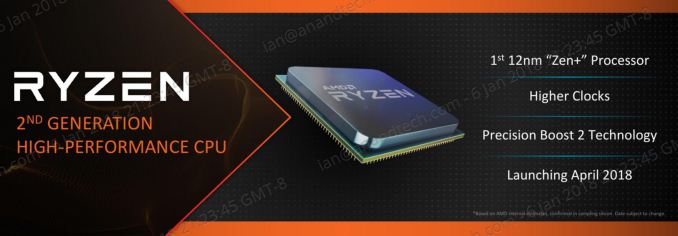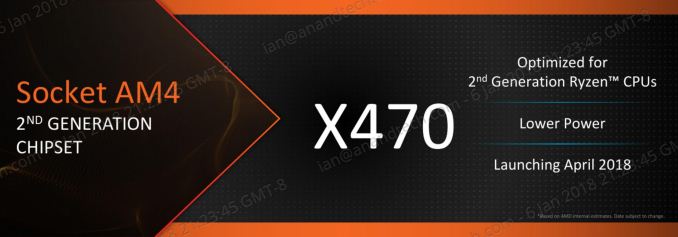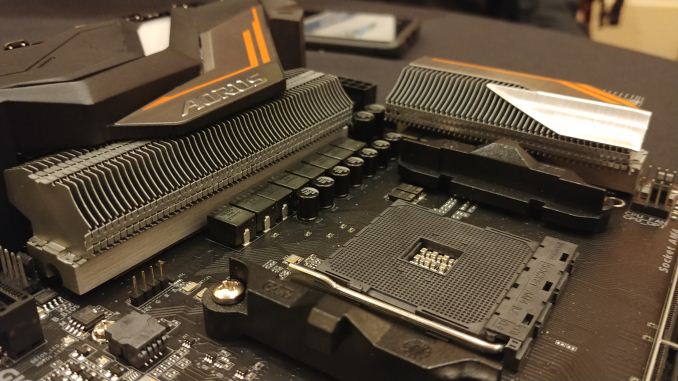AMD Tech Day at CES: 2018 Roadmap Revealed, with Ryzen APUs, Zen+ on 12nm, Vega on 7nm
by Ian Cutress on February 1, 2018 8:45 AM EST2nd Generation Ryzen
AMD has always stated that its Zen core design will form the basis of its high-performance x86 processors for the foreseeable future. This has included, among other things, a cadence with releasing updates and new Zen-like processor designs into the market. As announced at Tech Day, the update to 1st Generation Ryzen will be 2nd Generation Ryzen, coming in April 2018.
Specific core counts, frequencies, or model numbers were not mentioned – we are still 2-3 months away from this launch. AMD did state a number of points worth discussing however, especially with its decision to use GlobalFoundries newest 12nm ‘LP’ design process (12LP), compared to the 14nm ‘LPP’ design process (14LPP) used in the first generation Ryzen products.
First I want to go to this graph, to show what AMD want to claim on raw performance over the next three years:
This is a graph of raw performance, combining both the efficiency of processing instructions (IPC, instructions per clock) as well as benefits from an improved manufacturing process. AMD cites the industry trend as growing 7-8% every year, and that they fully expect the Zen package, due to design improvements in the microarchitecture and better foundry notes, will go above and beyond that 7-8% figure.
So first up along that line is Zen+. This will be the name of the core in the 2nd Generation Ryzen family, built on GlobalFoundries 12LP process. AMD has categorically stated that the core microarchitecture underneath has not changed: we will still have the same front-end and back-end as Zen, with the same size caches and the same layout. What has changed will be some of the power management algorithms, and perhaps some tweaks to the neural network-based prefetch algorithms. This will be headlined as ‘Precision Boost 2’ support, which is a feature that has already been introduced to the Ryzen with Vega graphics components (desktop and mobile).
GlobalFoundries 12LP
Most of the physical changes happen due to the process. Last year, AMD cited that its second generation Ryzen products will be on a ‘14+’ manufacturing node, but now it is going to be on a 12LP process. Some people argue that this is a clever marketing ploy as a name change, given nothing in the designs actually comes close to 14nm or 12nm. We were told that 12LP implements stricter design rules for the manufacturing process, requiring changes to library layout and the floorplan, but with an end result of a focus on performance per watt.
For the new processors, AMD is claiming a 10% boost in performance per watt overall. This is going to be taken as higher clocks for the same power at the high-end and lower power for the same frequency for more power sensitive products. AMD’s slide from Jim Anderson’s presentation above specifically says ‘higher clocks’, which when combined with Mark Papermaster’s presentation which states ‘10%+ performance vs. 14LPP’, we could take this to mean that we should expect anywhere from an 8%+ increase in frequencies with 2nd Generation Ryzen for desktop (not 10%, accounting for the fact that the power/efficiency curve gets worse the faster you are).
| Comparison of 14 nm Branded Process Technologies | |||||||
| GlobalFoundries 12LP |
GlobalFoundries 14HP |
GlobalFoundries 14LPP ? |
TSMC 16FF |
Intel 14nm |
|||
| Fin Pitch | ? | ? | ? | ? | 42 nm | ||
| Gate Pitch | ? | ? | 78 nm | 90 nm | 70 nm | ||
| Min Metal Pitch | ? | ? | 64 nm | 64 nm | 52 nm | ||
| Gate Height | ? | ? | less than 480 nm | 480 nm | 399 nm | ||
| Metal Layers | 13 | 17 | 13 | unknown | unknown | ||
| Design Library | 7.5T | 12T | 9T | 9T | unknown | ||
The 10% figure is corroborated by GlobalFoundries, who back in 2017 stated that its 12LP process will offer a 10% better performance. GF also stated that the 12LP process also offers a 15% area reduction against 14LPP. This is done, according to GlobalFoundries, by using 7.5T libraries rather than 9T libraries. This requires its customers to ‘recompile’ their 14LPP designs for the adjusted 12LP process.
To put this into context, this means we might see 4.3-4.5 GHz processors with the 2nd Generation Ryzen sticker where we used to see 4.0 GHz processors. It will be interesting to see how AMD and GlobalFoundries have moved that seemingly hard overclock limit we saw on processors like the Ryzen 7 1800X, which had a hard time moving past 4.2 GHz on all cores.
We are having a tour around GlobalFoundries Fab 8 in New York this week, and are set to spend some time with CTO Gary Patton, talking about the new process. While he is unlikely to quote specifically about how AMD has used the new design rules to its advantage, he might tell us some more information about the process in general.
As for 2nd Generation Ryzen, we are told that the major motherboard vendors and OEMs already have near-final engineering samples to hand to ensure updated compatibility.
New Motherboards: X470 Chipset and AM4 Motherboards
Launching around the same time as the new processors will be a range of X470 motherboards from the main motherboard manufacturers. Strictly speaking, these motherboards are not needed: the current AM4 motherboards based on the X370/B350/A320 chipsets on the market will accept the new processors (as well as APUs) with a relevant BIOS update. However, AMD plans to optimize its high-end chipset with a few new features.
What we know so far is that the new X470 chipset is designed for lower power. How that is achieved, AMD would not go into at this point, however the fact that the X370 chipset was an outsourced product through ASMedia built on TSMC’s 55nm process would point to at least one way AMD could save power: building it on TSMC’s 40nm process for a start. We are told that the X370 and X470 chipsets are pin-compatible, which is not a limit to this theory, but an interesting point nonetheless.
AMD has stated that the new chipsets will be optimized better for the newer processors, which can be translated as better memory support and a few newer features. We were told that X470 will have very specific new features, although AMD did not want to disclose anything until we get closer to the launch.
We were lucky enough to see a GIGABYTE based X470 motherboard at CES.
You can read our analysis on this motherboard here.
Second Generation Threadripper
In the second half of 2018, AMD will launch a second generation of Threadripper, based on the new 12LP process. AMD did not go into specific details here, mainly because the launch is so far away, but users should look forward to the same improvements as the standard Ryzen products: up to 10% better raw performance due to the improved manufacturing process, Precision Boost 2 support, and better memory compatibility.
We are not expecting anything to change on core counts or other features like PCIe lanes.














131 Comments
View All Comments
Ian Cutress - Sunday, January 7, 2018 - link
Hey everyone, thanks for coming to read about AMD's roadmaps. I want to go into a lot more detail on what came out of AMD's Tech Day, particularly about APUs, 12nm, 7nm, Vega, new APU pricing, the X470 chipset and so on, but a pretty bad strain of CES flu is doing the rounds and this year I'm an unlucky recipient. It's not completely debilitating, but bad enough for me to lose concentration that I might have to cancel a few meetings at the show tomorrow as a result if I can't string a coherent thought together.Rather than post a garbled mess, I want to get around to detailing the news for you all properly, as there's a lot of nuances to go into. We also had an interview with Dr. Lisa Su about AMD in 2018. Stay tuned for updates over the next couple of weeks, as I stay hydrated and call room service for chicken soup!
Eris_Floralia - Monday, January 8, 2018 - link
Ian, isn't Ryzen 3 2200U utilizing a new dual core die?They did have a dual core die with 3 CUs on their former roadmap.
Ian Cutress - Monday, January 8, 2018 - link
AMD has one die design covering the whole of Ryzen Desktop + Threadripper + EPYC, and one die design covering Ryzen Mobile + Ryzen APUs. They're not going to spend a third amount of money on masks for a single low-end dual-core die with a few CUs unless it was going to expand into a new segment of products. Given that AMD has been quite open about its 2018 roadmap today, I doubt that would happen.Eris_Floralia - Monday, January 8, 2018 - link
Thanks Ian.I'm also quite surprised they didn't announce the new die on CES if it will be coming. So it's just harvested dies....
mczak - Monday, January 8, 2018 - link
Well there is a 2 core / 3 CUs design on the roadmap - Banded Kestrel. This is however intended for embedded. Although it is rather similar to the Bristol Ridge / Stoney Ridge split, and the latter also showed up in non-embedded markets.However, just like Stoney Ridge, Banded Kestrel will be limited to single-channel memory. I always assumed it's going to show up in cheap notebooks/PCs, basically as a Pentium Silver competitor, but of course I could be wrong (in any case, it's not ready yet).
StevoLincolnite - Monday, January 8, 2018 - link
Error on the second page in the table..."Vega 3
3 CPUs
192 SPs"
Should be:
"Vega 3
3 CUs
192 SPs"
Krysto - Monday, January 8, 2018 - link
Next time, supplement 10,000 IU Vitamin D3 a day, months before CES. You can thank me later.Dave Null - Monday, January 8, 2018 - link
This is actually very good advice.Most of us who sit in front of computers all day aren't getting enough vitamin D. Vitamin D plays a major regulatory role in our immune systems. Since realizing I was deficient in vitamin D a few years ago (your doctor can easily test for this), I've been supplementing it, and getting sick far less often as a result.
Rοb - Wednesday, January 24, 2018 - link
But I smoke heavily, drink coffee almost continuously, eat poorly and avoid the Sun, and don't take vitamin supplements.I haven't been sick in decades ...
Not that I would advise anyone to smoke nor offer medical advice but there's flu shots (which I also don't have) that will reduce your vulnerability rather than copy my lifestyle.
MFinn3333 - Thursday, February 1, 2018 - link
The problem with that attitude is that you are chipping away at your body's natural defenses against all kinds of diseases, such as COPD, over time.You are born with a lot of over-provision inside each of your organs. Those activities are eating away faster than normal. What happens when you run out of extra "space"? Same as on an SSD Degraded performance or size.